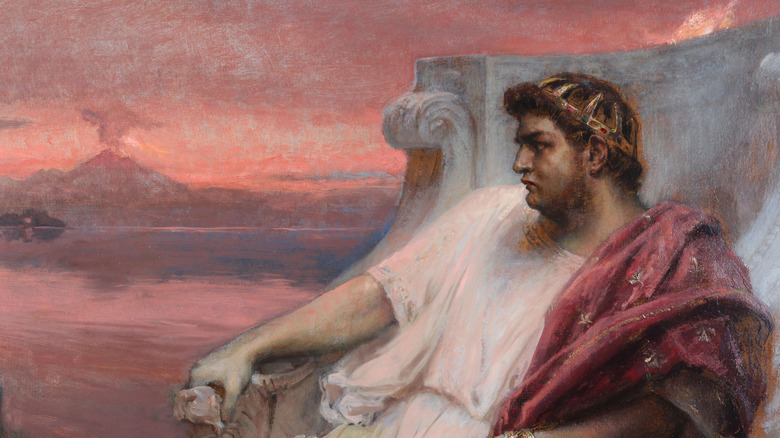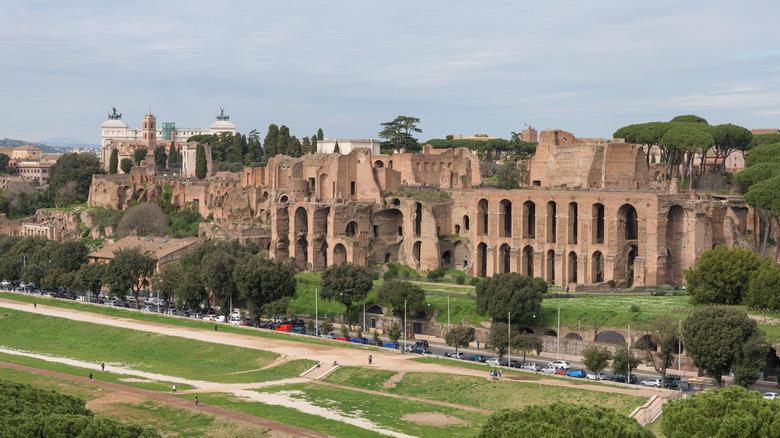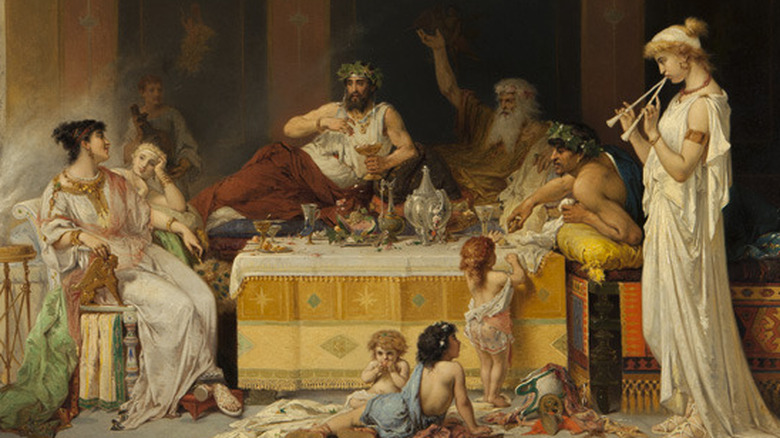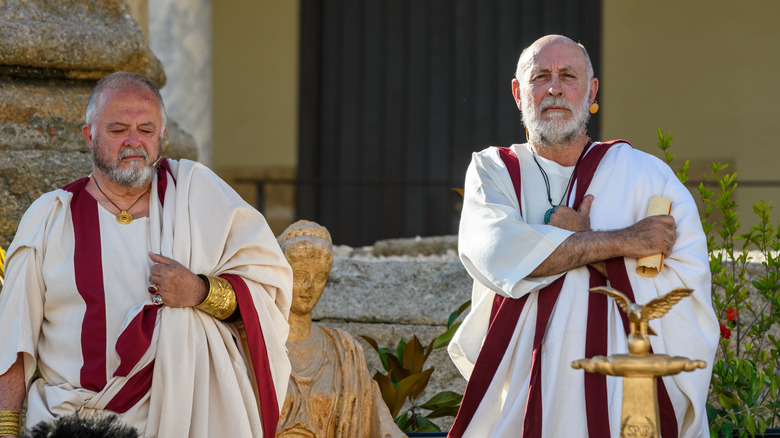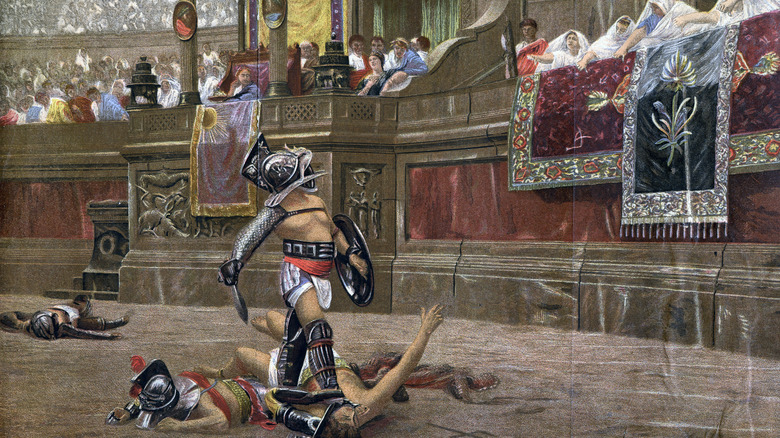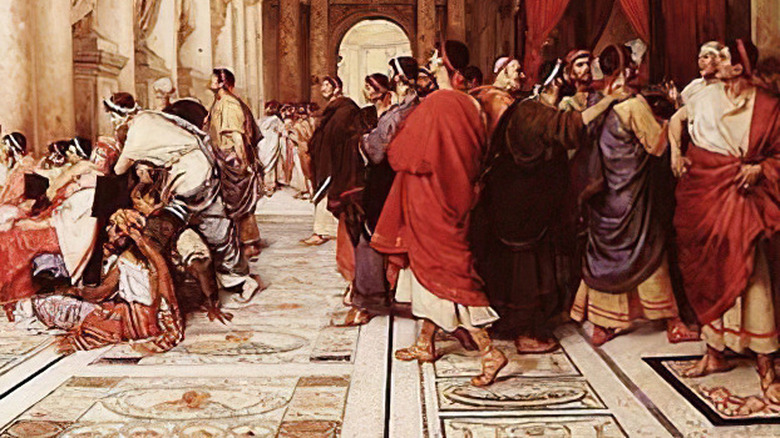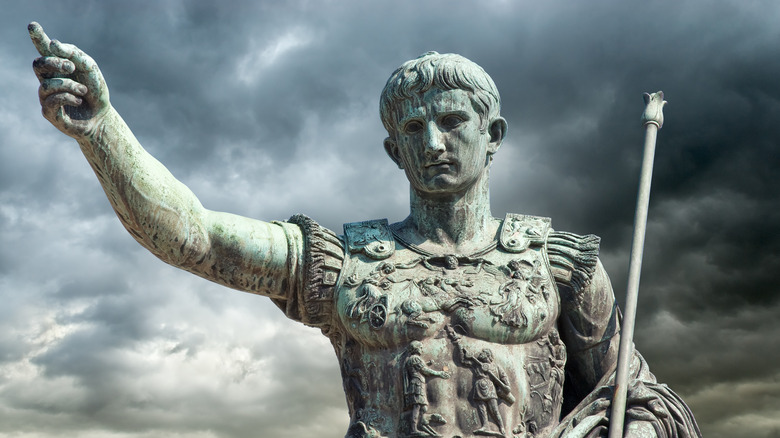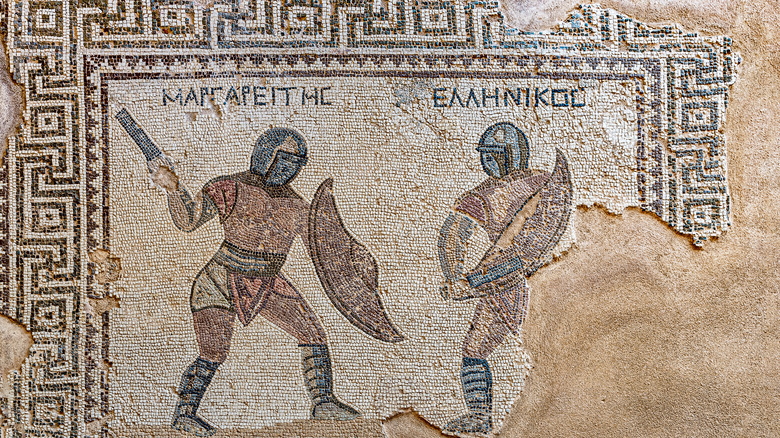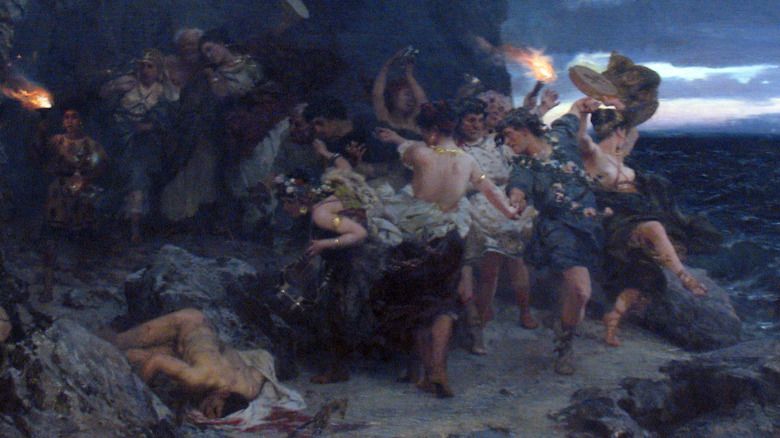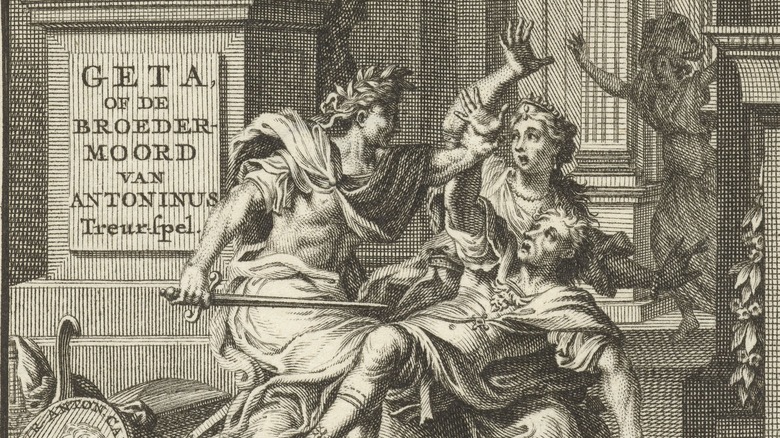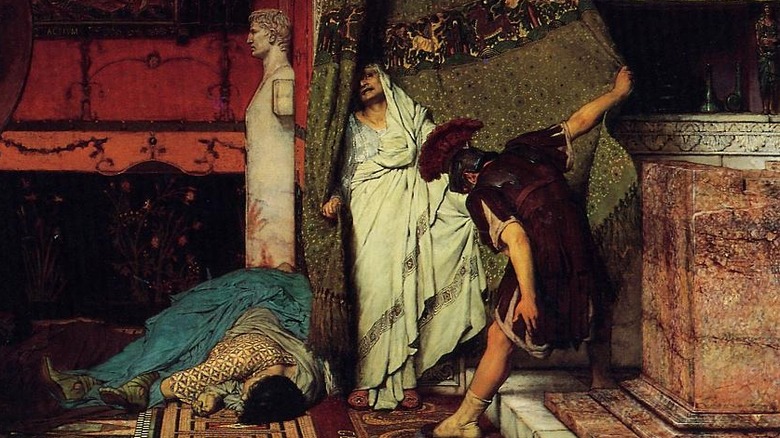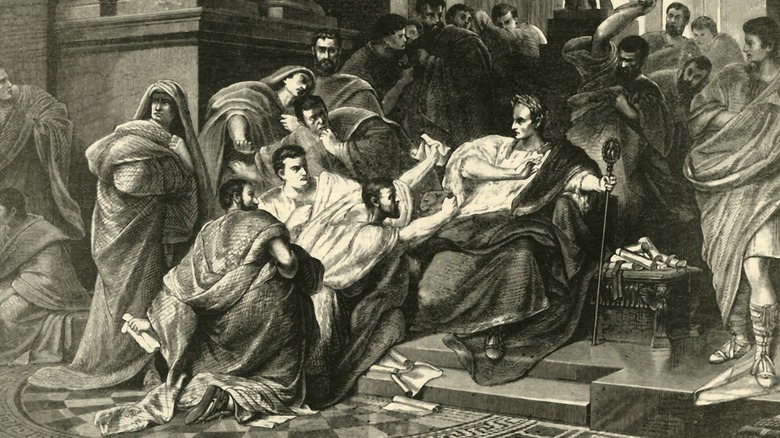What Life As A Roman Emperor Was Really Like
What would your life be like if you had ultimate power and seemingly limitless resources at your disposal? That is essentially what it was like to be a Roman emperor. According to the World History Encyclopedia, the office of the emperor was established by Octavian after his defeat of Mark Antony. After the victory, his troops declared him imperator which is a term tied to military victory. This title morphed into emperor over time. As for Octavian, who took the title Augustus, which means "revered," even though he was the first emperor, he preferred the title princeps, meaning first, or leader. Even so, by the time Augustus died in A.D. 14, he had virtually limitless powers over a very large and powerful empire.
You'd think that life would be very good for the emperor. In some respect, there were definite perks to the job. However, there were deadly downsides. So wrap yourself up in a toga as we take a look at the good, the bad, and truly hideous elements of the life of being a Roman emperor.
Roman emperors lived at the finest address
The toniest address in ancient Rome was the Palatine Hill and the Roman emperors made sure they had the nicest homes on the block. According to Britannica, the Palatine Hill was central to the history of Rome, being the legendary site where Rome's founders, Romulus and Remus, were suckled as orphans by a she-wolf. Throughout the Republic, leading citizens built their homes on the Palatine, and during much of the imperial period, it became the de facto home of the imperial household. As "Rome" explains, Augustus built his palace on the Palatine which was greatly expanded by his successor Tiberius. By the time of Emperor Domitian (ruled A.D. 81 to 96), the entire hill had become enclosed, effectively separating the emperor and his household from the rest of the populace.
"The Architecture of Rome" explains that this Domus Flavia was a huge, rambling structure that had immense rooms for matters of state as well as numerous private chambers. So impressive was this home upon the Palatine, that the word "palace" has its origins in the Palatine. The Palatine was the home of Roman emperors until the time of Emperor Constantine (ruled A.D. 324 to 337). During his reign, the capital and the imperial household were relocated to Constantinople.
Roman emperors ate rich foods
While Roman emperors did not have the variety of food we do today because plants native to the Americas such as potatoes, corn, and tomatoes were unknown to them, they did the best with what they could at lavish Roman banquets. NPR points out that these feasts were held by not just Roman emperors, but aristocrats in general. Some of the recipes offered by the Roman gourmand Marcus Gavius Apicius illustrate to what lengths the Roman elite would go to show off that they had the wherewithal to eat anything. This includes brain sausage, peacock, sow's womb, and stuffed dormouse. Apicius himself had the pleasure of serving the sons of Emperor Tiberius with baked nightingales slathered with honey and stuffed with prunes (via NPR).
Not all Roman emperors ate like this. Augustus promoted how he ate and drank in moderation, like a simple Roman, as a way to create goodwill with the masses. So too did some other emperors that are usually well esteemed by historians such as Marcus Aurelius, Hadrian, and Trajan — though Trajan could drink with the best of them (via NPR). Yet the majority of emperors tended toward luxury with exotic feasts. However, one myth that has endured is that Romans would force themselves to vomit between courses at a vomitorium so that they could eat more. Scientific American points out that vomitoriums were the entrances and exits to stadiums that seemed to "vomit" people.
They wore purple
The traditional form of Roman dress was the toga which was pretty much like a big white blanket that was folded about the wearer. According to "The Myth of the Toga: Understanding the History of Roman Dress" most Romans probably did not wear togas on a daily basis because they were cumbersome affairs. Togas were used to define rank throughout the early history of Rome with color and pattern defining what social class you were. According to Brittanica, the toga fell out of use, first by women and then the lower classes, before it finally became an aristocratic dress worn by officials and the emperor. By that time, togas had become so elaborate with such a distinct number of folds that slaves were used to help dress their masters.
The toga the emperor wore was colored purple. This tradition probably started before the empire proper began when, according to "Dictator: the Evolution of the Roman Dictatorship," Julius Caesar started wearing a solid purple toga which he may have invented himself or have copied from the styles of ancient Etruscan kings. Regardless, purple displayed wealth and power since making the dye was, as New York Times explains, a tedious process where marine snails were collected and boiled for days in lead vats. It smelled pretty bad. The color purple was therefore expensive. Because of Julius Caesar, the subsequent emperors adopted the color purple as a sign of their power and majesty.
Roman emperors watched gory entertainment
Deadly contests in the arena were as Roman as the fermented fish sauce garum. That is, they were very Roman indeed. In the late Roman Republic, ambitious politicians staged games, either chariot racing, gladiator contests, or animal hunts, as a manner to gain prestige and power. Thus, after the fall of the Republic, emperors were expected to provide ample entertainment in the form of games. History points out that the purpose of an emperor sponsoring games was to show his affluence but also to win the affection of the people and thereby help cement his power. Some emperors put on lavish events. Trajan held a 123-day festival which resulted in the slaughter of some 11,000 animals either by spectacle hunting or pitted against one another.
Then there were gladiatorial contests. These deadly man-to-man and sometimes woman-to-woman contests usually resulted in death by one or the other fighter. The World History Encyclopedia tells us that the largest venue for this was the Flavian Amphitheater in Rome, better known as the Colosseum. The emperor was expected to attend events and could issue mercy or death to a fallen gladiator — usually by a blow from his adversary. Typically, the crowd would shout either "Mitte!" ("release him") or "Iugula!" ("execute him"). The emperor was often swayed by the crowd in what may have been the last democratic institution left of the Roman state.
They had little me time
Roman emperors, like any other head of state, were busy people, and getting some alone time would have been a tricky proposition. Every emperor had an entourage with some larger than others. The general trend was that entourages increased throughout the history of Rome. One example of this is provided by the World History Encyclopedia when it describes Emperor Hadrian (ruled A.D. 117 to 138). Hadrian traveled throughout the empire for most of his reign. He may have had as many as 5,000 people in his following which included family, court officials, guards, slaves, hangers-on, various servants, and scholars.
Under Diocletian (ruled A.D. 284 to 305) the court greatly expanded in size in part to instill a sense of sacredness in the emperor. This was done for good reason since before Diocletian, the empire had been in a state of anarchy for nearly 50 years with 20 different emperors being deposed usually by violent means.
They got to be a god
What is the life of a god like? "Invented History, Fabricated Power," tells us that the Roman emperors, until the time of Constantine in the second century, were deified. Britannica explains that this cult of the emperor was developed even before Augustus who had pressed for his great uncle Julius Caesar to be deified after his assassination in 44 B.C. Doing so was a way to create a unifying belief throughout the empire. Much of the cult of the emperor was to acknowledge his genius which quickly spread as an act of patriotism. Yet there were problems. The BBC points out that emperors were usually worshiped only after death since worshiping a living person as a god was not considered acceptable in some provinces. It also was objected to by monotheistic religions like Judaism and Christianity.
Yet some emperors couldn't wait till death to be a god. For example, Caligula (ruled A.D. 37 to 41) started cross-cultural taboos by proclaiming his godhood. The Roman historian Suetonius wrote, "[Caligula] ordered all the images of the gods, which were famous either for their beauty, or the veneration paid them, among which was that of Jupiter Olympius, to be brought from Greece, that he might take the heads off, and put on his own." Then there was Commodus (ruled A.D. 180 to 192). According to the World History Encyclopedia, this son of the capable Emperor Marcus Aurelius declared himself Hercules reborn.
Roman emperors exercised your slightest sociopathic whim
The mantra "absolute power corrupts absolutely" can be applied liberally to a number of Roman emperors. As emperor, you could do (at least at first) pretty much do whatever you want. Many examples are illustrated in the aptly named book, "Evil Roman Emperors" which points out that even the more esteemed emperors acted badly. Still, some emperors are really called out for sadistic behavior. The World History Encyclopedia cites Caligula as one of the most inhumane rulers ever to don the purple. He killed his suspected enemies, executed his first wife, and enjoyed watching torture and murder.
Another notorious emperor is Nero (ruled A.D. 54 to 68). He ended up murdering his mother and kicked his pregnant second wife to death. Then there was Elagabalus (ruled A.D. 218 to 222) who broke sacred Roman taboos. Among other things, this emperor (who was a teenager) tried to supplant all Roman religions in the empire with the worship of a single Syrian deity. He then married a Vestal Virgin (a big no-no). He also, according to the Historia Augusta, had decadent feasts where he murdered his guests by smothering them to death with a cascade of flower petals from a drop ceiling.
Roman emperors fought in gladiatorial combat and always won
As mentioned, most emperors staged games, but one decided to take it a step further and participate. According to Britannica, Commodus, who thought of himself as a reincarnated Hercules, wanted to prove his divine cred in the Colosseum. He was obsessed with the games. The Roman historian Cassius Dio related how the emperor would first participate in hunting spectacles by killing from his platform above the arena floor. Bears, domestic animals, an elephant, a tiger, and a hippopotamus were brought to him in nets, all from a safe distance.
He then took part in sparring matches against gladiators using wooden weapons. Commodus' gladiatorial get-up was the secutor style which entailed carrying a large shield and short sword. There is no reason to doubt it when Cassius Dio implies that Commodus was allowed to win all of these bouts. Commodus was even given a million sesterces for each one of these victories. The main point with Commodus's behavior was, that while gladiatorial contests were fantastically popular in Rome, participating in them was far beneath any aristocrat, much less the emperor. This and his general propensity toward sadism and megalomania got him strangled to death by an athlete while taking a bath (via Cassius Dio).
They could embrace taboo
Some Roman emperors were notorious for ignoring cultural taboos. The chief example of this is again, Caligula. "The Origins and Role of Same Sex Relations in Human Societies" comments that Caligula engaged in homosexual activities with several members of his imperial circle. However, it is important to point out that this practice, according to Britannica, while not fully normalized, was certainly less taboo than it became when Judeo-Christianity became the prevailing religion.
What was restricted were other activities Caligula reportedly engaged in which included incest with his sister while his wife was present. Yet incest was not limited to Caligula. According to the World History Encyclopedia, his successor Claudius (ruled A.D. 41 to 54) married his niece Agrippina the Younger (who happened to be Caligula's sister). Then Claudius' successor, Nero (Agrippina's son), was also considered sexually depraved. According to the Roman historian Suetonius, Nero "...so prostituted his own chastity that after defiling almost every part of his body, he at last devised a kind of game, in which, covered with the skin of some wild animal, he was let loose from a cage and attacked the private parts of men and women, who were bound to stakes, and when he had sated his mad lust, was dispatched."
Roman emperors had a family who you mistrusted and mistrusted you
If you were a Roman emperor, your family life was dysfunctional at best. Aside from the unorthodox types of relationship you may have with your kin, they were also the ones most likely to try to off you. "Evil Roman Emperors" recalls as an example the deadly purges conducted by the emperor Caracalla (ruled A.D. 211 to 217) who didn't put a lot of importance on family ties. Caracalla was in constant power struggles with his co-emperor and brother Geta. Caracalla, after multiple assassination attempts, had Geta murdered while Geta tried to seek shelter in their mother's arms.
A number of Roman emperors viewed their families as a mortal threat. Another dysfunctional familial relationship was between the emperor Nero and his mother Agrippina the Younger. The World History Encyclopedia reports that early in Nero's reign, Agrippina attempted to consolidate power for herself. This set up a confrontation with Nero as he matured in which he forced her to retire and then plotted her murder. First, he devised a ceiling in her bedchamber that would collapse on her while she slept. This proved too complicated. He then built a boat devised to sink. But when Agrippina sailed on it, and it sank, she swam to safety. Ultimately, he just had his guards kill her without pretension. Her final words according to the Roman historian Tacitus were, "Smite my womb."
They lived only for a short time
Roman emperors had no term limits so if you became the emperor you may expect to be in office for years and years. However, the truth of the matter is that Roman emperors on average did not live long enough to have a long reign. One article, entitled "Causes of Death Among the Caesars," examines the deaths of 77 emperors over the period from 27 B.C. to A.D. 476. They found that during the early empire, until A.D. 193, emperors ruled an average of 12.7 years as compared to the later empire until A.D. 476, where they ruled for an average of six years.
Early emperors were more likely to die by suicide when compared to the latter group. On the whole, early emperors were more likely to die of natural causes or illness when compared to their later successors who were more likely to be murdered or executed (over half). In total, 33 emperors were murdered, with the method being by a sword or sharp weapon. The three outliers were strangled, hanged, and stoned.
So if you were to be a Roman emperor, you'd be better off being an emperor during the early empire rather than the latter — your average life expectancy was 53.4 years as opposed to 46.
They lived by the rule of paranoia
You might think that, based on the premature and violent deaths often exchanged for absolute power, Roman emperors probably were paranoid. But in their case, this is a misdiagnosis. The saying, "It isn't paranoia if they're really out to get you," very much applies to the Roman emperors.
One of the cleverest emperors, Diocletian (ruled A.D. 284 to 305) came into power at the end of a very violent period of Roman history which saw the assassination of a number of emperors. The political instability was so bad that the Roman state was close to collapse. However, according to "In Praise of Later Roman Emperors," Diocletian sought to avoid the constant assassinations and plotting by gradually instituting elaborate court rituals which separated the emperor from other people. He would dress in elaborate garb fully bejeweled and rich in silk. "The Emergence of Christianity" explains that one ceremony was the adoratio purpurae which means "adoration of the purple." This meant that anybody who wished to approach the emperor had to do so on their knees and kiss his purple robe of the dominus et deus (lord and god).
However, while Diocletian retired and died a natural death, his successors continued to make daily life for the emperors one of righteous paranoia. But, if you like power and a short lifespan, maybe it was a good trade-off.
